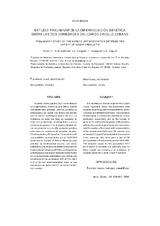Estudio preliminar de la diferenciación genética entre las dos variedades del cerdo criollo cubano
Preliminary study of the genetic differentiation between two variety of cuban creole pig
Autor
Segura, D.
Pérez, E.
Martínez Martínez, Amparo
Velázquez Rodríguez, F.J.
Delgado-Bermejo, J.V.
Editor
Universidad de Córdoba, Servicio de PublicacionesFecha
2004Materia
MicrosatélitesVariedad
METS:
Mostrar el registro METSPREMIS:
Mostrar el registro PREMISMetadatos
Mostrar el registro completo del ítemResumen
It is admitted an Iberian origin for the Cuban Creole Pig breed. Inside this breed there exist varieties morphologically very well defined, as the Unhaired and Middlehaired types. The existence of these types is traditionally admitted by Cuban producers, researchers and by the society in general. To confirmate the genetic differentiation of these two morphological types, we have analyzed 93 samples of the breed, with representation of the middlehaired (MD) type (58 animals) and unhaired (UH) type (35 animals) taken from several Cuba provinces. We have used a test of 20 microsatellites of the recommended by FAO/ISAG. The obtained values for the parameters GST (0.74 and 0.12 percent) are extremely low. All these results are showing a no existence of varieties inside the Cuban Creole Pig breed. Al cerdo Criollo Cubano (cCC) se le atribuye un origen ibérico. Dentro de este último existen variedades bien definidas, como la Lampiña y la Entrepelada, las cuales han tenido representación al menos morfológica dentro del cCC. La existencia de estos dos tipos es aceptada en Cuba por productores, investigadores y por la sociedad en general. Con el objetivo de determinar la existencia o no de diferenciación genética entre ellos, se analizaron 93 animales, de ellos, 58 entrepelados y 35 lampiños. Se emplearon 20 microsatélites recomendados por la FAO/ISAG (International Society of Animal Genetics) para estudios de biodiversidad porcina. Los microsatélites se amplificaron mediante la Reacción en Cadena de la Polimerasa (PCR) y los fragmentos amplificados se separaron mediante electroforesis en un secuenciador automático. Los valores que se obtienen en los parámetros GST, 0,74 p.100 y 0,12 p.100 son extremadamente bajos, lo que demuestra que dentro del cCC no existe subdivisión varietal.

